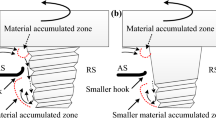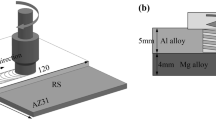Abstract
The structural elements of T-joints which include skin and stringer plates are extensively used in many fields due to their excellent properties. The high-strength joints can contribute significantly to effective construction. In this study, the dissimilar joint between 5083 and 7075 aluminum alloys was fabricated by different friction stir welding methods in T-lap shape. Four pins with different pin lengths were used to fabricate the joints in both single- and double-pass welding. In addition, when welding in two passes, the pins were offset toward the advancing side and the pin rotations were reversed. The interaction of pin length, pin offset, and inverse material flow in the interface formation was clarified. The fracture behavior of the T-joins was explored in both skin and stringer tests. Experimental results showed that the pin length made a minor contribution to weld improvement in single-pass welding. In double-pass welding, the interfacial morphology was significantly improved by utilizing a suitable pin length and offsetting the pin toward the advancing side. In the latter case, a notable oxide layer was eliminated along the interface. A solid quality of the joint was observed with small kissing bond defects, and a high tensile and fatigue strength (about 90% joint efficiency in both skin and stringer tensile tests) was found. Notably, the use of a short pin length was ineffective solution in fragmenting the oxide layer during both single- and double-pass welding. To clarify these results, the interfacial formation and crack propagation behavior of the T-joints were analyzed.





















Similar content being viewed by others
References
Friedrich HE (2003) Challenges of materials technology for low consumption vehicle concepts. Adv Eng Mater 5:105–112. https://doi.org/10.1002/adem.200390014
Gallo P, Guglielmo M, Romanoff J, Remes H (2018) Influence of crack tip plasticity on fatigue behaviour of laser stake-welded T-joints made of thin plates. Int J Mech Sci 136:112–123. https://doi.org/10.1016/j.ijmecsci.2017.12.011
Feistauer EE, Bergmann LA, dos Santos JF (2018) Effect of reverse material flow on the microstructure and performance of friction stir welded T-joints of an Al-Mg alloy. Mater Sci Eng A 731:454–464. https://doi.org/10.1016/j.msea.2018.06.056
Peng P, Wang W, Zhang T, Liu Q, Guan X, Qiao K, Cai J, Wang K (2022) Effects of interlayer metal on microstructures and mechanical properties of friction stir lap welded dissimilar joints of magnesium and aluminum alloys. J Mater Process Technol 299:117362. https://doi.org/10.1016/j.jmatprotec.2021.117362
Mishra RS, Ma ZY (2005) Friction stir welding and processing. Mater Sci Eng R 50:1–78. https://doi.org/10.1016/j.mser.2005.07.001
Kashaev N, Ventzke V, Çam G (2018) Prospects of laser beam welding and friction stir welding processes for aluminum airframe structural applications. J Manuf Process 36:571–600. https://doi.org/10.1016/j.jmapro.2018.10.005
Silva ACF, Braga DFO, de Figueiredo MAV, Moreira PMGP (2014) Friction stir welded T-joints optimization. Mater Des 55:120–127. https://doi.org/10.1016/j.matdes.2013.09.016
Costa DM, Jesus JS, Loureiro A, Ferreira JAM, Borrego LP (2014) Fatigue life improvement of mig welded aluminum T-joints by friction stir processing. Int J Fatigue 61:244–254. https://doi.org/10.1016/j.ijfatigue.2013.11.004
Jesus JS, Costa JM, Loureiro A, Ferreira JM (2017) Fatigue strength improvement of GMAW T-welds in AA 5083 by friction-stir processing. Int J Fatigue 97:124–134. https://doi.org/10.1016/j.ijfatigue.2016.12.034
Oliveira PI, Costa JM, Loureiro A (2018) Effect of laser beam welding parameters on morphology and strength of dissimilar AA2024/AA7075 T-joints. J Manuf Process 35:149–160. https://doi.org/10.1016/j.jmapro.2018.08.003
Cui L, Yang X, Zhou G, Xu X, Shen Z (2012) Characteristics of defects and tensile behaviors on friction stir welded AA6061-T4 T-joints. Mater Sci Eng A 543:58–68. https://doi.org/10.1016/j.msea.2012.02.045
Tavares SMO, Castro RAS, Richter-Trummer V, Vilaça P, Moreira PMGP, de Castro PMST (2010) Friction stir welding of T-joints with dissimilar aluminium alloys: mechanical joint characterisation. Sci Technol Weld Join 15(4):312–318. https://doi.org/10.1179/136217109X12562846839114
Jesus JS, Costa JM, Loureiro A, Ferreira JM (2018) Assessment of friction stir welding aluminum T-joints. J Mater Process Technol 255:387–399. https://doi.org/10.1016/j.jmatprotec.2017.12.036
Hou X, Yang X, Cui L, Zhou G (2014) Influences of joint geometry on defects and mechanical properties of friction stir welded AA6061-T4 T-joints. Mater Des 53:106–117. https://doi.org/10.1016/j.matdes.2013.06.061
Fratini L, Buffa G, Micari F, Shivpuri R (2009) On the material flow in FSW of T-joints: influence of geometrical and technological parameters. Int J Adv Manuf Technol 44:570–578. https://doi.org/10.1007/s00170-008-1836-3
Martin JP, Stanhope C, Gascoyne S (2011) Novel techniques for corner joints using friction stir welding: In book: Friction Stir Welding and Processing VI, pp 177–186. https://doi.org/10.1002/9781118062302.ch22
Zeng S, Chen G, Dinaharan I, Liu Q, Zhang S, Sahu PK, Wu J, Zhang G, Shi Q (2020) Microstructure and tensile strength of AA6082 T-joints by corner stationary shoulder friction stir welding: effect of tool rotation speed. J Mater Eng Perform 29:7094–7103. https://doi.org/10.1007/s11665-020-05179-w
Suna T, Roy MJ, Strong D, Simpson C, Withers PJ, Prangnell PB (2019) Weld zone and residual stress development in AA7050 stationary shoulder friction stir T-joint weld. J Mater Process Technol 263:256–265. https://doi.org/10.1016/j.jmatprotec.2018.08.022
Zhao Y, Zhou L, Wang Q, Yan K, Zou J (2014) Defects and tensile properties of 6013 aluminum alloy T-joints by friction stir welding. Mater Des 57:146–155. https://doi.org/10.1016/j.matdes.2013.12.021
Cui L, Yang X, Xie Y, Hou X, Song Y (2013) Process parameter influence on defects and tensile properties of friction stir welded T-joints on AA6061-T4 sheets. Mater Des 51:161–174. https://doi.org/10.1016/j.matdes.2013.04.013
Mustafa FF, Kadhym AH, Yahya HH (2015) Tool geometries optimization for friction stir welding of AA6061-T6 aluminum alloy T-joint using Taguchi method to improve the mechanical behavior. J Manuf Sci Eng 137(3):031018. https://doi.org/10.1115/1.4029921
Annual Book of ASTM Standards (2004) Test methods for tension testing of metallic materials, E08. ASTM Int
Sato YS, Takauchi H, Park SHC, Kokawa H (2005) Characteristics of the kissing-bond in friction stir welded Al alloy 1050. Mater Sci Eng A 405:333–338. https://doi.org/10.1016/j.msea.2005.06.008
Le Jolu T, Morgeneyer TF, Denquin A, Gourgues-Lorenzon AF (2015) Fatigue lifetime and tearing resistance of AA2198 Al–Cu–Li alloy friction stir welds: effect of defects. Int J Fatigue 70:463–472. https://doi.org/10.1016/j.ijfatigue.2014.07.001
Guerra M, Schmidt C, McClure JC, Murr LE, Nunes AC (2002) Flow patterns during friction stir welding. Mater Charact 49(2):95–101. https://doi.org/10.1016/s1044-5803(02)00362-5
Zeng XH, Xue P, Wang D, Ni DR, Xiao BL, Ma ZY (2018) Effect of processing parameters on plastic flow and defect formation in friction-stir-welded aluminum alloy. Metall Mater Trans A 49(7):2673–2683. https://doi.org/10.1007/s11661-018-4615-2
Ahmed MMZ, Sabbah A, El-Sayed Seleman MM, Ammar HR, Essam A (2017) Friction stir welding of similar and dissimilar AA7075 and AA5083. J Mater Process Technol 242:77–91. https://doi.org/10.1016/j.jmatprotec.2016.11.024
Kalemba-Rec I, Kopyściański M, Miara D, Krasnowski K (2018) Effect of process parameters on mechanical properties of friction stir welded dissimilar 7075–T651 and 5083–H111 aluminum alloys. Inter J Adv Manuf Technol 97(5–8):2767–2779. https://doi.org/10.1007/s00170-018-2147-y
Ge Z, Gao S, Ji S, Yan D (2018) Effect of pin length and welding speed on lap joint quality of friction stir welded dissimilar aluminum alloys. Int J Adv Manuf Technol 98:1461–1469. https://doi.org/10.1007/s00170-018-2329-7
Zhou N, Song D, Qi W, Li X, Zou J, Attallah MM (2018) Influence of the kissing bond on the mechanical properties and fracture behavior of AA5083-H112 friction stir welds. Mater Sci Eng A 719:12–20. https://doi.org/10.1016/j.msea.2018.02.011
Acknowledgements
Hao Dinh Duong was funded by Vingroup JSC and supported by the Postdoctoral Scholarship Programme of Vingroup Innovation Foundation (VINIF), Institute of Big Data, code: VINIF.2021.STS.07.
Funding
Hao Dinh Duong was funded by Vingroup JSC and supported by the Postdoctoral Scholarship Programme of Vingroup Innovation Foundation (VINIF), Institute of Big Data, code: VINIF.2021.STS.07.
Author information
Authors and Affiliations
Contributions
All authors contributed to the study conception and design. Conceptualization, investigation, formal analysis, and writing original draft were done by Hao Dinh Duong. Methodology, validation, review, and editing were done by Tra Hung Tran. Review and editing were done by Dac Dung Truong. Supervision, validation, and writing—reviewing and editing were done by Masakazu Okazaki. All authors read and approved the final manuscript.
Corresponding author
Ethics declarations
Competing interests
The authors declare no competing interests.
Additional information
Publisher's note
Springer Nature remains neutral with regard to jurisdictional claims in published maps and institutional affiliations.
Rights and permissions
About this article
Cite this article
Duong, H.D., Tran, T.H., Okazaki, M. et al. Pin length, pin offset, and reversed metal flow interaction in the improvement of dissimilar friction stir welded T-lap joints. Int J Adv Manuf Technol 121, 4677–4689 (2022). https://doi.org/10.1007/s00170-022-09629-8
Received:
Accepted:
Published:
Issue Date:
DOI: https://doi.org/10.1007/s00170-022-09629-8




